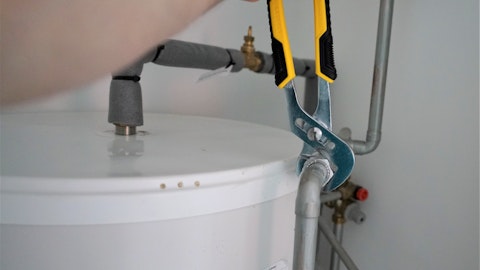Erik Gershwind: I would – I’m sorry to interrupt you, but I would call it general slowing. The real interesting thing here is it’s hard to find a bright line between what’s auto related and what’s not. And what I mean by that is we have some direct auto exposure. The bigger issue for MSC, of course, is what would be coded as a machine shop, a fab shop, a lot of – there’s a portion of their business that is auto related. So there’s tentacles to the strike that extend, beyond just the direct SIC codes, if you’d look at auto. But more broadly, I would say general softening. You certainly do have some pockets of strength still like aerospace, of course, but more general softening, again, I think, consistent with what we’ve been tracking with the IP and the sentiment readings.
Stephen Volkmann: Got it. Okay. Thanks. And then just a quick follow-up. Kristen, are you assuming that gross price is positive in ’24?
Kristen Actis-Grande: Yes, gross price will be positive in ’24, Steve. I’d assume about one to two points of growth from price in ’24.
Stephen Volkmann: Okay. Thank you.
Kristen Actis-Grande: You’re welcome.
Operator: Thank you. And our next question today comes from Tommy Moll with Stephens Inc. Please go ahead.
Thomas Moll: Good morning. And thanks for taking my question.
Erik Gershwind: Good morning, Tom.
Kristen Actis-Grande: Good morning, Tommy.
Thomas Moll: One follow-up on the ’24 discussion we’ve been having. Kristen, I think I heard you say in terms of volumes, you expect them lower. I think that was a first half comment, but I just want to make sure, that we’ve got the right time frame there?
Kristen Actis-Grande: Yes, you heard that right, Tommy. Lower in the first half, of course, Q1, we kind of talked about here with what’s going on with the UAW and the general industrial softening, and then the expectation that UAW alleviates in early Q2. So what I would – how I would think about kind of what changes first half to second half then is UAW headwind goes away. And then we also have, as we talked about in the prepared remarks. Two key things coming online that drive growth in the second half. One is some changes that we’re making around our pricing strategy. And then the second is, of course, the changes we’re making to the e-commerce platform, and both of those are intended to really reenergize the growth rate in the core customer space, which has been lagging the growth rate we’ve seen for the broader company overall.
So that is – that, along with just the change in the macro piece drive sequential improvement in the second half. We’ve got a bunch of other growth initiatives that we’re working on. I’d say there’s a runway on the large account wins that we’ve had in the past year, particularly in the second half of ’23 that provide upside through a year. But those are a few things that, I would point to that create the inflection first half to second half that we’re expecting.
Thomas Moll: That’s helpful. Thank you. I also wanted to follow-up on auto. If you have these numbers, it would be great, if you could provide them, just what you estimate your direct and indirect exposures are just in terms of percent of revenue? And just any more anecdotes you can give, where you may be able to discern it. It’s more just general customer caution. So maybe not directly “strike impacted”, but more just a sentiment headwind in that ecosystem that you’ve seen manifest? Thank you.
Erik Gershwind: Yes. Sure, Tommy. So to answer your first question, direct exposure, roughly in the range of 10%, maybe a little bit under 10%. Indirect exposure, as I mentioned, tough to get our arms around specifically, but – certainly, it would take that number up considerably when we were referring to kind of MSC’s bread and butter of machine shops, fab shops and job shops. So that’s in terms of the first part. In terms of the color I’d provide. We stay pretty close to the ground with our sales force. And we’re getting regular reports and some of the reports are temporary halts in production, which would be sort of a more direct example of what we’re talking about due to a strike either at a customer or a customer of a customer.
And then the other is, as you said, there are customers who are further down in the chain in the auto supply chain, who are expressly more caution, and are just clamping down on spending. And we have examples of that, where some of our vending customers that’s basically buy only what you need. And so, we’re seeing a lot of the – almost like what we described in the MSC world of clamping down on discretionary spending, we’re seeing the same thing at a lot of our customers.
Thomas Moll: Thank you. I appreciate it. I’ll turn it back.
Operator: And our next question today comes from Ken Newman at KeyBanc. Please go ahead.
Ken Newman: Hi, good morning, guys.
Kristen Actis-Grande: Good morning, Ken.
Erik Gershwind: Good morning, ken.
Ken Newman: Good morning. Touch back on to the UAW stuff a little bit more here. Obviously, you’re assuming that strike alleviate by the end of the calendar year. I’m just curious just how much visibility do you have there in terms of what gives you comfort in making that assumption? And obviously, the range in the guidance is a bit wide for this coming year. So at the lower end, what are you kind of assuming in terms of a potential impact, if that strike lasts a little bit longer than you anticipated?
Erik Gershwind: Well, Ken, what I’d say is you could see, I mean, we’re tracking towards the lower end of the range through September and our estimate for October, right? So that gives you a feel for, if this were to continue, what would have to be the case for the lower end. We’re kind of in it now. And look, we had to make some assumptions. Our visibility is somewhat narrow, as you limited like all of us. As you suggested, that’s why the range is slightly larger. But look, I think the punchline is if this were extended, you’re seeing what it’s doing now. But certainly, to the extent this alleviates itself at some point, there is a lift to come. And then as we were talking with Dave earlier, if there were a bounce in response, more of a lift.
And obviously, in the meantime, all the while Ken, we’re focused on share capture. And so, I was encouraged while we can only control so much, I was encouraged right out of the gates in September, despite the lower growth our sales team’s execution was strong. So vending signings up over 50%. VMI signing is up over 25%. Those are the things that Kristen mentioned sort of a build in back half some of the initiatives coming online. In addition to some of the bigger programs, just better execution in a tough environment, when local distributors are vulnerable, gives us confidence, because all of those signings will lead to new agreements, which lead to revenue as we move along the fiscal.



